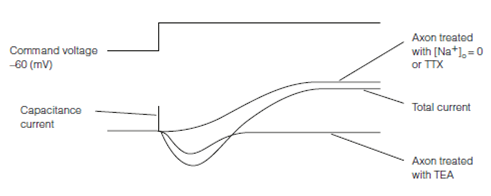Voltage clamping
The ion fluxes which underlie neuron action potentials were discovered in the early year 1950s using methods called voltage clamping that remains a key method in neurophysiology. Voltage clamping measures the currents that flow across an excitable cell membrane at a fixed potential. It is very important to measuring currents because it gives information on that ions might be responsible for changes in membrane potential. (I) Current cannot directly be found from potential (V) it needs, additionally, the membrane resistance (R). Only if both R and V are known can I be calculated from Ohm’s law, V = IR. Voltage clamping circumvents this problem through measuring the transmembrane potential and having a feed- back amplifier in the circuit that injects into the cell the current which is required to keep the membrane potential constant; which is, the voltage is clamped. The current which must be injected through the circuit to keep the voltage fixed has to be the same size as the current flowing by the ion channels which would generally cause the potential to change. The voltage at that the membrane is clamped is called the command voltage. Through examining the currents which flow across a membrane over a range of command voltages it is possible to determine that ions carry the currents.
The use of voltage clamping is described in Figure that describes an experiment in that the giant axon of a squid is initially clamped at its resting potential of -60 mV and the command voltage is then trigger to zero. This first gives increased to a capacitance current as the change in voltage alters the amount of charge stored on the nerve cell membrane.
After the capacitance current comes an early inward current followed through a late outward current. These are the currents which generally flow during an action potential. In a solution when the squid axon is bathed which contains no sodium the early inward current is abolished. This shows in which the early inward current is carried through Na+. The same result is seen if an axon immersed in normal seawater is poisoned with the neurotoxintrodotoxin (TTX). Through binding to the external mouth of the Nav, TTX prevents Na+ from permeating by the channel. TTX added to any nerve preparation abolishes action potentials. Same as, tetraethyl ammonium (TEA) that blocks Kvs, when added to the bathing medium abolishes the late outward current showing which it is carried through K+.

Figure: A voltage clamping experiment to show the currents that flow during an action potential. Outward currents are upward directions, inward currents downwards directions. Initially the neuron is clamped at -60 mV, and the step to 0 mV generates first a capacitance current, then the ionic currents. The experiment is done with the axon under three different conditions. See text for details. TTX, Tetrodotoxin; TEA, tetraethylammonium.